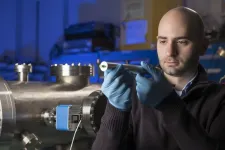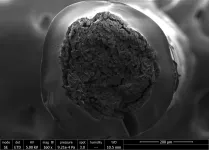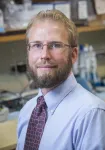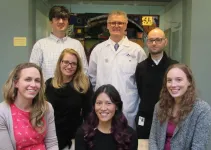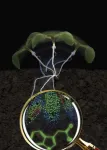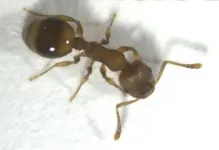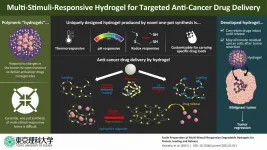(Press-News.org) AMHERST Mass. - The long-awaited first results from the Muon g-2 experiment at the U.S. Department of Energy's Fermi National Accelerator Laboratory show fundamental particles called muons behaving in a way that is not predicted by scientists' best theory, the Standard Model of particle physics. This landmark result, made with unprecedented precision and to which UMass Amherst's David Kawall's research group made key contributions, confirms a discrepancy that has been gnawing at researchers for decades.
"Today is an extraordinary day, long awaited not only by us but by the whole international physics community," said Graziano Venanzoni, co-spokesperson of the Muon g-2 experiment and physicist at the Italian National Institute for Nuclear Physics. "A large amount of credit goes to our young researchers who, with their talent, ideas and enthusiasm, have allowed us to achieve this incredible result."
"It's fantastically interesting to work on," says Kawall, a professor in UMass's physics department. "Everything matters. Every little detail matters, and all future theories of physics will have to be compatible with this result."
A muon is about 200 times as massive as its cousin, the electron. Muons occur naturally when cosmic rays strike Earth's atmosphere, and particle accelerators at Fermilab can produce them in large numbers. Like electrons, muons act as if they have a tiny internal magnet. In a strong magnetic field, the direction of the muon's magnet precesses, or wobbles, are much like the axis of a spinning top or gyroscope. The strength of the internal magnet determines the rate that the muon precesses in an external magnetic field and is described by a number that physicists call the g-factor. This number can be calculated with ultra-high precision.
Kawall's group, which included postdocs David Flay and Jimin George, graduate student David Kessler, and undergrad Alysea Kim, worked on measuring the strength of the magnetic field through which the muons passed, as well as preparing the magnet itself, a feat requiring almost unimaginable precision. "One of the innovations we were responsible for," says Kawall, "was developing a system involving 8,000 sheets of laser-cut iron foil to make the magnetic field as homogenous as possible. With our system, we were able to achieve results nearly three times better than the previous experiment." The team also spent years developing special calibration probes of incredible fidelity, accurate down to 15 parts per billion.
As the muons circulate in the Muon g-2 magnet, they also interact with a quantum foam of subatomic particles popping in and out of existence. Interactions with these short-lived particles affect the value of the g-factor, causing the muons' precession to speed up or slow down very slightly. The Standard Model predicts this so-called anomalous magnetic moment extremely precisely. But if the quantum foam contains additional forces or particles not accounted for by the Standard Model, that would tweak the muon g-factor further.
"This quantity we measure reflects the interactions of the muon with everything else in the universe. But when the theorists calculate the same quantity, using all of the known forces and particles in the Standard Model, we don't get the same answer," said Renee Fatemi, a physicist at the University of Kentucky and the simulations manager for the Muon g-2 experiment. "This is strong evidence that the muon is sensitive to something that is not in our best theory."
With more than 200 scientists from 35 institutions in seven countries, the Muon g-2 collaboration has now finished analyzing the motion of more than 8 billion muons from that first run.
"So far we have analyzed less than 6% of the data that the experiment will eventually collect. Although these first results are telling us that there is an intriguing difference with the Standard Model, we will learn much more in the next couple of years," says Fermilab scientist Chris Polly.
"Pinning down the subtle behavior of muons is a remarkable achievement that will guide the search for physics beyond the Standard Model for years to come," said Fermilab Deputy Director of Research Joe Lykken. "This is an exciting time for particle physics research, and Fermilab is at the forefront."
INFORMATION:
More images of the Muon g-2 experiment are available here.
A fact sheet is available here.
Contacts: Tracy Marc,
media@fnal.gov
David Kawall,
kawall@physics.umass.edu
Daegan Miller,
drmiller@umass.edu
Sutures are used to close wounds and speed up the natural healing process, but they can also complicate matters by causing damage to soft tissues with their stiff fibers. To remedy the problem, researchers from Montreal have developed innovative tough gel sheathed (TGS) sutures inspired by the human tendon.
These next-generation sutures contain a slippery, yet tough gel envelop, imitating the structure of soft connective tissues. In putting the TGS sutures to the test, the researchers found that the nearly frictionless gel surface mitigated the damage typically ...
Published in the Proceedings of National Academy of Sciences, researchers in the Climate Intervention Biology Working Group -- including Jessica Hellmann from the University of Minnesota Institute on the Environment -- explored the effect of solar climate interventions on ecology.
Composed of climate scientists and ecologists from leading research universities internationally, the team found that more research is needed to understand the ecological impacts of solar radiation modification (SRM) technologies that reflect small amounts of sunlight back into space. The team focused on a specific proposed SRM strategy -- referred ...
BIRMINGHAM, Ala. - Race associates with the risk of death from end-stage heart failure. So, identifying the molecular determinants of that risk may help the pursuit of the novel diagnosis and prognosis of heart failure, and its therapy.
A University of Alabama at Birmingham study of end-stage heart-failure patients has found that cytosine-p-guanine, or CpG, methylation of the DNA in the heart has a bimodal distribution among the patients, and that race -- African American versus Caucasian -- was the sole variable in patient records that explained the difference. A subsequent ...
More than 20 years after the discovery of the parkin gene linked to young-onset Parkinson's disease, researchers at The Ottawa Hospital and the University of Ottawa may have finally figured out how this mysterious gene protects the brain.
Using human and mouse brain samples and engineered cells, they found that the parkin protein works in two ways. First, it acts like a powerful antioxidant that disarms potentially harmful oxidants in the brain, including dopamine radicals. Second, as the brain ages and dopamine radicals continue to build up, parkin sequesters these harmful molecules in a special storage site within vulnerable nerve cells, so they can continue to ...
CHARLOTTESVILLE, Va. -- If, as the saying goes, less is more, why do we humans overdo so much?
In a new paper featured on the cover of Nature, University of Virginia researchers explain why people rarely look at a situation, object or idea that needs improving -- in all kinds of contexts -- and think to remove something as a solution. Instead, we almost always add some element, whether it helps or not.
The team's findings suggest a fundamental reason that people struggle with overwhelming schedules, that institutions bog down in proliferating red tape, and, of particular ...
Mobility tracking using cell phone data showing greater movement of people is a strong predictor of increased rates of COVID-19, according to new data in CMAJ (Canadian Medical Association Journal).
"This study shows that mobility strongly predicts [severe acute respiratory syndrome coronavirus 2] SARS-CoV-2 growth rate up to 3 weeks in the future, and that stringent measures will continue to be necessary through spring 2021 in Canada," writes Dr. Kevin Brown, Public Health Ontario, with coauthors.
Until Canadians are widely vaccinated against SARS-CoV-2, nonpharmaceutical public health interventions such as physical distancing and limiting social contact will be the main population-based means of controlling the spread of the virus.
"Mobility ...
While studying genetic diversity in bumblebees in the Rocky Mountains, USA, researchers from Uppsala University discovered a new species. They named it Bombus incognitus and present their findings in the journal Molecular Biology and Evolution.
Bumblebees are vital for agriculture and the natural world due to their role in plant pollination. There are more than 250 species of bumblebee, and they are found mainly in northern temperate regions of the planet. Alarmingly, many species are declining due to the effects of climate change, and those with alpine and arctic habitats are particularly threatened. However, the full diversity of bumblebee ...
The hormone auxin is of central importance for the development of plants. Scientists at the University of Bayreuth and the Max Planck Institute for Developmental Biology in Tübingen have now developed a novel sensor that makes the spatial distribution of auxin in the cells of living plants visible in real time. The sensor opens up completely new insights into the inner workings of plants for researchers. Moreover, the influences of changing environmental conditions on growth can now also be quickly detected. The team presents its research results in the journal Nature.
The effects of the plant hormone auxin were first described ...
Ants react to social isolation in a similar way as do humans and other social mammals. A study by an Israeli-German research team has revealed alterations to the social and hygienic behavior of ants that had been isolated from their group. The research team was particularly surprised by the fact that immune and stress genes were downregulated in the brains of the isolated ants. "This makes the immune system less efficient, a phenomenon that is also apparent in socially isolating humans - notably at present during the COVID-19 crisis," said Professor Susanne Foitzik, who headed up the study at Johannes ...
Cancer therapy in recent times relies on the use of several drugs derived from biological sources including different bacteria and viruses, among others. However, these bio-based drugs get easily degraded and therefore inactivated on administration into the body. Thus, effective delivery to and release of these drugs at target tumor sites are of paramount importance from the perspective of cancer therapy.
Recently, scientists have discovered unique three-dimensional, water-containing polymers, called hydrogels, as effective drug delivery systems (DDSs). Drugs loaded into these hydrogels remain relatively stable owing to the network-like structure and organic tissue-like consistency of these DDSs. Besides, drug release from hydrogels can ...
